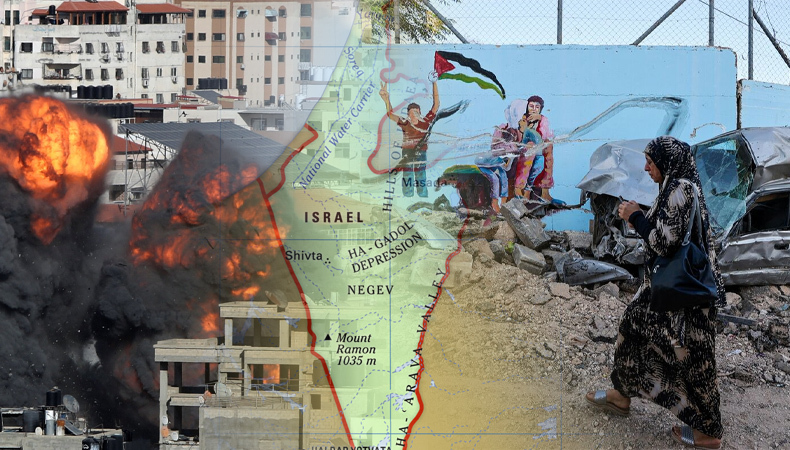Unabated Palestinian Displacement: Israel Attack on Jenin Camp Creates 4,000 New Refugees

Twelve Palestinians, including four children, were killed in a recent Israeli army attack on the Jenin refugee camp, and one Israeli soldier was also killed. Up to 4,000 Palestinians were displaced and an additional 143 were injured, 20 of whom were in critical condition.
Also Read – Israeli Minister Orders Removal Of Palestine Flags From Public Spaces
Although other aspects of the Israeli operation have received more media coverage, this mass displacement is crucial to comprehending the politics of the area.
Modern Palestine and Israel have always been characterised by forced migration as a central force. Israel’s occupation of the West Bank and Gaza Strip is structured around restricting movement, and the majority of Palestinians are refugees.
This conflict is ultimately about demographics, displacement, and mobility, even though it is frequently framed as a conflict of religion and ideology.
Why is Jenin a camp for refugees?
Why there is a refugee camp in the West Bank has been a major topic of discussion on social media this week regarding Jenin. It’s a question that demonstrates the West’s and Israel’s widespread historical ignorance. In actuality, there are eight in the Gaza Strip and 19 in the West Bank. The United Nations has registered more than 2 million Palestinians in the two territories as refugees, and it is their initial eviction that is at the root of the current violence.
In contrast to the initial 55% allotted by the UN to the fledgling Jewish state, 78% of Palestine was taken over when the state of Israel was founded in 1948. 750,000 Palestinians, or about three-quarters of the population, became refugees after being forcibly driven out by Zionist militias or fleeing violent crimes and other atrocities.
The Nakba (Palestinian for “the catastrophe”) is the term used to refer to these events, and it is remembered every year by refugee communities all over the Middle East.
The West Bank (including East Jerusalem) and the Gaza Strip are the two Palestinian territories that did not become a part of Israel after the Nakba, where the refugees initially sought refuge. People who had nowhere else to stay were housed in camps. One such camp was in Jenin, which primarily housed refugees from Haifa and Nazareth.
The United Nations adopted Resolution 194 at the conclusion of 1948, urging the refugees to be given permission to return to their homes as soon as possible. Israel’s successive governments have consistently opposed this, and as a result, the refugees have continued to live in exile and uncertainty.
By the year 2023, more than three generations of refugees have sought refuge in Jenin. More than 14,000 people live there, crammed onto a plot of land that is less than half a kilometre square. This week, up to 4,000 Palestinians were uprooted from the camp, making them refugees once again. This has happened before; in 2002, Israel attacked Jenin, which resulted in the displacement of 4,000 people, or more than a quarter of the camp’s population at the time.
Palestinians have been displaced ever since 1948, and it still continues today. The West Bank and the Gaza Strip, which came to be known as the Occupied Palestinian Territories, were taken over by the Israeli army in 1967. As a result, almost 400,000 Palestinians were forced to flee their homes, more than half of them twice. To accommodate them, Jordan established six new refugee camps.
Martial law is imposed on millions of civilians by the Israeli occupation. The regime’s defining characteristics are displacement and immobility. Both uprooting already-existing Palestinian communities and restricting their freedom of movement by taking land across the region are frequently involved in the construction of illegal Israeli settlements.
Israeli policies that result in ongoing Palestinian displacement in addition to land grabs include forced evictions, home demolitions, denial of residency rights, and discriminatory planning and zoning. As a result, Palestinians must constantly worry about being uprooted and have no protection for their civil rights because they are a population under occupation.
Palestinians in the occupied territories struggle in every situation to negotiate their rights without making citizenship claims. Israeli eviction orders against Palestinians in the East Jerusalem neighbourhood of Sheikh Jarrah to make room for Israeli settlers are among the most well-known recent instances of forcible relocation. Masafer Yaffa, a Palestinian community in the southern West Bank, faces eviction as Israel seizes the land for military training.
Palestinians in Gaza, meanwhile, are experiencing a different kind of displacement. Despite Israel’s 2005 withdrawal of its settlements from the Gaza Strip, the ongoing waves of violence there have caused Palestinians to continue losing their homes. During the 2021 airstrike on Gaza, 72,000 people were forced to flee after 2,200 homes were destroyed and another 37,000 were damaged.
A stark reminder of the ongoing nature of Palestinian forced migration, approximately 70% of Gaza’s population are refugees. To reflect this reality, the term “ongoing Nakba” is frequently used by Palestinians.
All of this is possible because the Palestinians lack fundamental rights as a result of their statelessness. While security and conflict resolution are frequently brought up in discussions about the peace process, for many Palestinians, ending their dispersion and displacement is the top priority.
Also Read – Palestine has legal right to become state member of UN: Riyad Mansour
Even though the attack on Jenin may have ended, there is no sign of a larger resolution or an end to the ongoing Palestinian displacement cycles.




